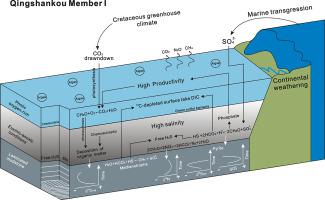当前位置:
X-MOL 学术
›
Chem. Geol.
›
论文详情
Our official English website, www.x-mol.net, welcomes your feedback! (Note: you will need to create a separate account there.)
Integrated chemostratigraphy (δ13C-δ34S-δ15N) constrains Cretaceous lacustrine anoxic events triggered by marine sulfate input
Chemical Geology ( IF 3.9 ) Pub Date : 2021-01-01 , DOI: 10.1016/j.chemgeo.2020.119912 Hansheng Cao , Wentong He , Fajin Chen , Xuanlong Shan , Deming Kong , Qinghua Hou , Xiaoqiang Pu
Chemical Geology ( IF 3.9 ) Pub Date : 2021-01-01 , DOI: 10.1016/j.chemgeo.2020.119912 Hansheng Cao , Wentong He , Fajin Chen , Xuanlong Shan , Deming Kong , Qinghua Hou , Xiaoqiang Pu

|
Abstract During the Late Cretaceous period (~100.5–65 million years ago), two episodes of expansive lake anoxia occurred in the Songliao Basin (~3× the size of Lake Superior), NE China, either lasting less than one million years. These events, known as lacustrine anoxic events (LAEs), were the factors driving the development of the main source rocks for the most productive oilfields in China. The details underpinning the initiation of the LAEs, however, remain problematic. As a test of this scientific issue, we present time series of bulk organic carbon isotopes, pyrite sulfur isotopes, nitrogen isotopes and trace element concentrations from the Turonian–Coniacian Qingshankou Formation in the Songliao Basin. A notable δ34S excursion (~−10‰) and a spike in pyrite sulfur content are recorded in the basal Qingshankou Formation when the basin reached the maximum expansion. We attributed these changes to marine transgression, which would have brought high sulfate concentrations to the lake, thereby promoting microbial sulfate reduction (MSR). Subsequent sulfate limited by MSR and pyrite burial associated with isolation of the lake from the seawater drove a 20‰ positive δ34S shift. Note that the modes of the δ34S that fluctuations we describe from the LAEs have also been recognized in marine black shale during Oceanic Anoxic Event (OAE) 2, implying a common signature of anoxia. The carbon isotope data suggest that the maximal fractionation found in Qingshankou Member I was likely a consequence of the increased [CO2]aq in lake water and inputs from chemoautotrophs. Increased sedimentary δ15N during the interval of Qingshankou Member I implies intensified denitrification in the oxygen minimum zone, which lowered the water-column N/P ratios, thereby stimulating bacterial nitrogen fixation in Qingshankou Members II-III. By comparing and summarizing the sulfur, carbon and nitrogen cycles of the LAEs during deposition of the Qingshankou and Nenjiang formations, we argue that the forcing function underlying LAEs was enhanced sulfate levels from marine transgression, which might have intensified nutrient recycling and further regulated the lacustrine carbon and nitrogen cycles.
更新日期:2021-01-01



























 京公网安备 11010802027423号
京公网安备 11010802027423号